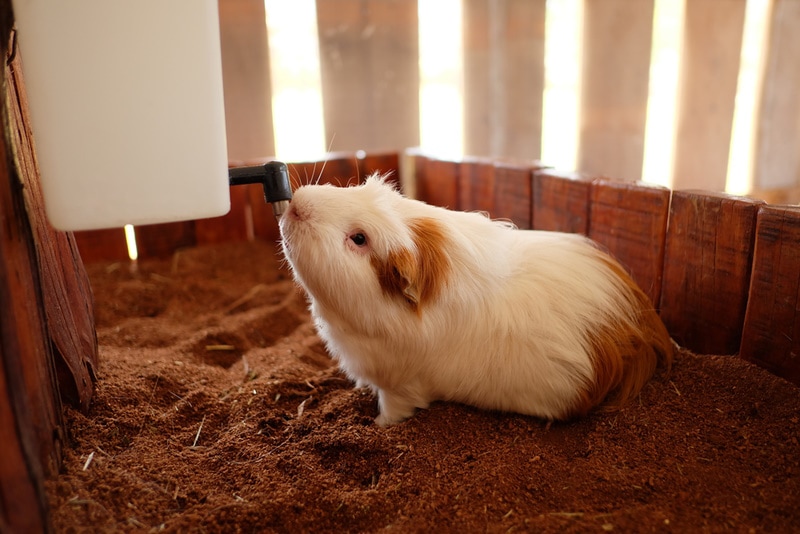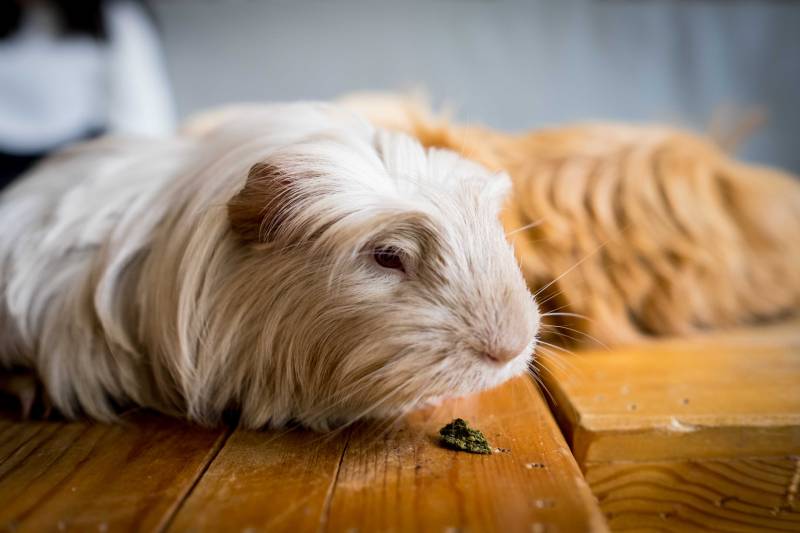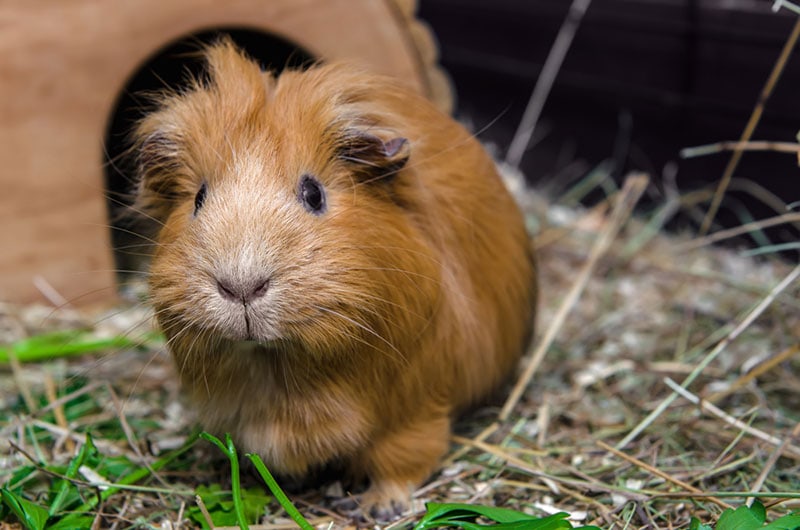How to Get Guinea Pigs to Drink Water: 5 Vet-Approved Tips
Updated on

Click to Skip Ahead
Water is vital for all living things. In most instances, guinea pigs will naturally locate and use any water source that is provided to them, but sometimes, they either aren’t getting enough water, or are not using the bottle or bowl in their hutch.
If your guinea pigs aren’t drinking water, you may be concerned about why. In most cases, it isn’t a big deal, as new or young guinea pigs may just need to learn where the bottle is and how to use it. But what if there is an underlying cause for their lack of hydration? Find out how to get guinea pigs to drink water in this article.
Top 3 Tips to Take to Get Your Guinea Pigs to Drink Water
After defining why your guinea pig isn’t drinking water, there are steps to take to get them to drink water from a bottle again. If your guinea has come home from the vet after being sick, it’s best to quarantine them until they can drink independently. A water bowl is often preferred for a recuperating cavy.
Whether your guinea pig is young, old, or getting better from being sick or injured, below is a list of steps to successfully introduce a water bottle to your pocket pal.
1. Choose The Perfect Bottle
It’s crucial to pick the right water bottle for your piggy pal. If the water bottle is too small, you’ll need to refill it more. Larger bottles may become stagnant or warm if not refreshed regularly.
Glass is the safest option for picking a water bottle, as it’s easier to clean and will not leach harmful chemicals into your bottle. While a glass bottle may be more expensive, they’ll last longer in the long run and keep your guinea pigs the healthiest they can be.
Aim for a medium bottle with about 300–450 ml of water when choosing a size glass bottle. Aim for small nozzle bottles for young guinea pigs learning how to use a water bottle.
Make sure the dropper is functioning correctly – a leaking bottle can be dangerous as it leads to wet and mouldy bedding and thirsty guinea pigs, and one that is blocked can be disastrous.

2. Consider Where to Place the Water Bottle
If you have multiple guinea pigs, ensure you have a couple of water sources at opposite ends to ensure there is access for all, and avoid any bullying that might occur. Assess the different sizes of pigs you have and ensure that there are bottles at appropriate heights to suit them; shoulder height is ideal.
If your guinea pig doesn’t know where the water is, try putting a small water bowl under the dropper, and remove it after a few days. That way they will come to that spot looking for water. If after 30 minutes or so, your guinea pigs still haven’t drunk from the bottle, tap the end of the dropper to show them where water comes from.
3. Use Food to Coax Your Guinea
Use tasty fruits like strawberry, watermelon or papaya and rub them over the end of the nozzle. If that doesn’t get them drinking, it’s time for a check-up with the vet to see if there is another reason they won’t drink.

Tips for Preventing Dehydration
To keep your guinea pigs healthy and hydrated follow these tips:
- Replace water at least once a day (twice a day or more in hot weather)
-
Wash glass bottles thoroughly at least once a week, or every cage cleaning
- if using plastic bottles, clean these every 2-3 days
- Provide fluid-rich fruits and vegetables
- Place water bottles in the same spot every time
- Check periodically that the water bottle is working properly, and make sure the bedding below it isn’t soaking wet*
- Provide a water bowl, as well as a bottle
*It is normal that there will be some water drips and spills under a water bottle. To help reduce bedding from becoming too damp, it is a good idea to place a shallow bowl or tray under the bottle to contain the overflow and keep surrounding bedding material dry. Ceramic dishes are ideal for this purpose, as well as for food and water – ceramic is better than plastic as it is harder to tip over and move around, can’t be chewed, and easier to keep clean.

How Much Water Does a Guinea Pig Need?
The daily minimum requirement of water a guinea pig needs is 80–100 ml or more per animal.
Keeping one large bottle in their cage or one small bottle per guinea pig is best, but do not provide an excessive amount that won’t get consumed in a day or two, as the water can stagnate or become warm. In hot weather, you should replace your guinea pig’s water at least twice daily.
Glass bottle water dispensers are the best in terms of keeping water cool, fresh, and clean, but there is the obvious risk of breakage. Plastic bottles tend to be more popular for this reason, but it is vital to ensure they are properly cleaned regularly. Even if your guinea pig drinks from a bottle, it is important to still provide your pets with a water bowl for drinking and cleaning themselves. They will make a mess of it, but they need to have a fresh bowl daily, especially in hot weather.
If guinea pigs don’t get the minimum water requirements daily, they may become dehydrated. Some signs of dehydration include:
- Lack of appetite
- Reduced or slowed energy
- Sunken eyes
- Dry gums
- Constipation
- Dry nose or skin
The easiest way to tell if your guinea pig is dehydrated is to pick up their skin gently. They need more water if it doesn’t snap back quickly. Another method is to check their urine. Keep them in a small area with some paper towels on the floor so you can clearly see when they pass urine. If the urine is quite dark and smells very strong, this may be a sign that they are dehydrated.

How Often Should a Guinea Pig Drink Water?
While there is no set answer about how often a guinea should drink water, they should typically drink water throughout the day. As they are constantly grazing and digesting, they will also need to be hydrating.
If you feed your guinea pig water-rich food like vegetables and fruit, they will drink less, which is perfectly normal. If you’re concerned about your guinea pig not drinking enough water, throw in some lettuce, celery, a few berries, or other high water content foods in their habitat.
It’s good to remember that as guinea pigs age, they require less water and won’t need to drink as often. Though, if you provide them with water-rich foods, they’ll stay happy and healthy.

Why Isn’t Your Guinea Pig Drinking Water?
Your guinea pig must get its minimum water requirements daily. However, if they refuse to drink, there is most likely a reason. As mentioned above, your guinea pig may need to learn where the water bottle is, or they might be too young to understand how to use it.
- They eat a lot of fluid-rich fruits and vegetables
- Your guinea’s front teeth are overgrown or infected
- There is a blockage in the water nozzle or trough
- The water smells bad or is contaminated
- They’re sick
- They’re stressed or being bullied
- Dietary changes
- They are older and not as mobile
It’s essential to understand the problem if your guinea pig refuses to drink. However, if you need more clarification, a call to the vet is your best option.

When to Worry
When all else fails, it might be time to worry. If you notice signs of dehydration after providing fluid-rich foods and accessible water resources, you need to contact your vet.
You must worry if your guinea pig shows signs of sickness or lack of appetite. If they aren’t eating, have constipation or diarrhea, or seem inactive or lethargic, call your vet to rule out possible causes and get treatment immediately.
Final Words
Guinea pigs—like all living things—need water to stay healthy. A guinea pig’s minimum water requirement is about 80–100 ml daily. If you notice your guinea pig is not drinking water, there are possible causes you must rule out first, such as age, diet, or bottle preference.
If your water bottles are working fine and you’ve provided fluid-rich foods and they’re still refusing to drink, a vet is the best option to seek immediate help and rule out underlying causes.
Featured Image Credit: Wuttipong.D, Shutterstock












